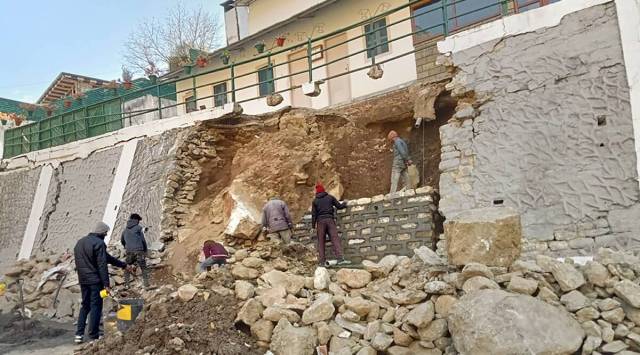Micro-seismic observatories to be set up in Joshimath this week: Union minister Jitendra Singh
Addressing the workshop, he said there was a critical need for fundamental research on the physical processes that lead to the failure of the brittle layers beneath the crust and sub-crust.
 Repair work underway following collapse of a wall in Joshimath area of Chamoli district, on Tuesday, Jan. 10, 2023. The town has been declared a disaster-prone area after large cracks appeared in homes and on roads. (PTI Photo)
Repair work underway following collapse of a wall in Joshimath area of Chamoli district, on Tuesday, Jan. 10, 2023. The town has been declared a disaster-prone area after large cracks appeared in homes and on roads. (PTI Photo) Union Earth Sciences Minister Dr Jitendra Singh Tuesday said the ministry will set up numerous micro-seismic observation systems at Joshimath, to study and gather data on whether the area had been suffering from small earthquakes and tremors. Cracks appeared in hundreds of houses as well as on roads at Joshimath in Uttarakhand earlier this month owing to land subsidence. This is the first time that micro-seismic observation centres will be set up in the Himalayan belt in India.
Singh made the announcement at the India-UK Workshop of Geosciences in New Delhi and said the observation systems will be in place by Thursday.
 People affected by the gradual “sinking” of Joshimath in Chamoli district of Uttarakhand after cracks appeared in their houses, in Joshimath, Uttarakhand, Monday, Jan. 9, 2023. (PTI Photo)
People affected by the gradual “sinking” of Joshimath in Chamoli district of Uttarakhand after cracks appeared in their houses, in Joshimath, Uttarakhand, Monday, Jan. 9, 2023. (PTI Photo)
Addressing the workshop, he said there was a critical need for fundamental research on the physical processes that lead to the failure of the brittle layers beneath the crust and sub-crust. Singh added that there is an increasing need for mitigation plans to be put in place.
A team from the Earth Sciences ministry will leave for Joshimath Wednesday and set up these observation centres at seven to eight different places outside Joshimath town. Joshimath falls in seismic Zone V.
 A house collapses at the landslide affected area of Joshimath, in Chamoli district, Monday, Jan. 9, 2023. (PTI Photo)
A house collapses at the landslide affected area of Joshimath, in Chamoli district, Monday, Jan. 9, 2023. (PTI Photo)
“There are two primary aspects which are important in earthquake observation – the location and the magnitude. When you have at least three stations in an area, you can observe earthquakes of 5 magnitude on the Richter scale, and as the number of observation centres increases, so does the accuracy as well as detection of much smaller earthquakes. There are currently 157 seismic centres in India which help us in tracking earthquakes of 3.5 magnitude and above, but we can’t track any earthquake smaller than this in the country
right now,’’ said a Ministry official.
Officials added that while earthquakes of bigger magnitude have a larger impact, much smaller earthquakes, especially when recurring, have an impact as well, especially on the stability of land, and in particular on slopes such as what Joshimath is built on.
“Moreover, the Joshimath region is in any case highly fragile. Joshimath itself is built on loose soil. So while the bigger earthquakes can even impact regions that have solid stable ground and big rocks, the smaller earthquakes can destabilise a place like Joshimath. What we will be trying to do through these observations is determine whether the subsidence at Joshimath has taken place because of earthquakes, or climatic changes such as increased excess precipitation or whether it isn’t the impact of natural causes at all but due to non-climatic factors such as the stress of increased development and infrastructure,’’ added the official.
While many of the larger cities in India already have micro-seismic observatories, on the basis of which policies of infrastructure development, building and construction are made, this is the first time that such observation centres will be set up in the Himalayan mountains. Delhi, for instance, already has micro-seismic observatories in place.
“In the near future, of course, we will have to look at expanding such centres to other parts of the Himalayas as well, and discussions are on,’’ said a Ministry official.
Meanwhile, Singh Tuesday informed the conference that the Ministry of Earth Sciences had already established 37 new seismological centres in the last two years for extensive observation facilities, and is planning to set up 100 more such seismological centres over the next five years for “improving real-time data monitoring and data collection”.
Addressing the workshop, Singh further said that scientific understanding of the processes behind disasters has grown immensely over the past 50 years, and there is a need for strengthening further international collaborations like the Indo-UK initiative to fight such disasters. The two-day workshop was attended by British High Commissioner Alex Ellis; Wendy Matcham, head, Natural Environment Research Council (NERC), UK Research and Innovation (UKRI); OP Mishra, director, National Centre for Seismology, and Sukanya Kumar, acting director, UK Research and Innovation India.







